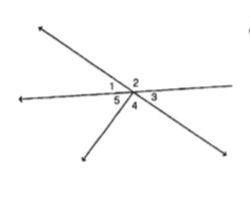
Mathematics, 10.04.2021 01:10 Cassandra100
A common is assuming that any pair of angles that are "across from each other" are vertical. In this figure , angle1 and angle3 are vertical angles because they are formed by intersecting lines. Angles 2 and 4 are not vertical angles. Name three other pairs of nonadjacent angles that are also not vertical.


Answers: 3


Other questions on the subject: Mathematics

Mathematics, 21.06.2019 17:00, ruslffdr
Arestaurant offers a $12 dinner special that has 5 choices for an appetizer, 12 choices for an entrée, and 4 choices for a dessert. how many different meals are available when you select an appetizer, an entrée, and a dessert? a meal can be chosen in nothing ways. (type a whole number.)
Answers: 1

Mathematics, 21.06.2019 17:30, hwhite41
Is trapezoid abdc the result of a dilation of trapezoid mnpq by a scale factor of ? why or why not? yes, because ab and cd are each the lengths mn and qp. yes, because sides ab and cd are parallel to sides mn and qp. no, because ab is the length mn but cd is the length qp. no, because sides ab and cd have different slopes from sides mn and qp.
Answers: 1

You know the right answer?
A common is assuming that any pair of angles that are "across from each other" are vertical. In this...
Questions in other subjects:

English, 03.04.2020 09:38

Chemistry, 03.04.2020 09:39

Mathematics, 03.04.2020 09:39


Mathematics, 03.04.2020 09:39

Mathematics, 03.04.2020 09:39



Mathematics, 03.04.2020 09:39

Physics, 03.04.2020 09:40



